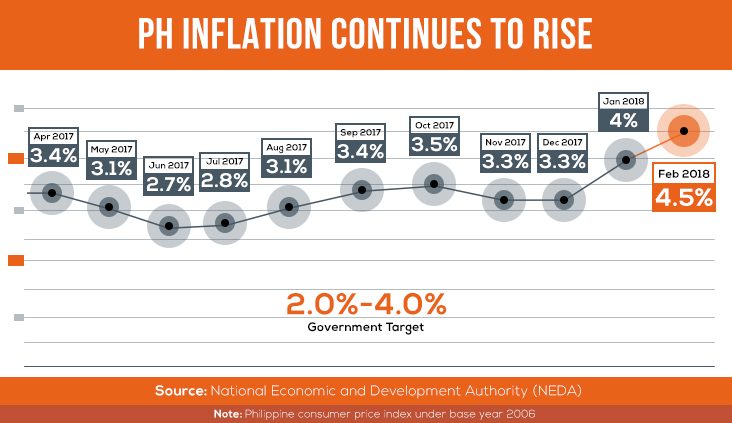SUMMARY
This is AI generated summarization, which may have errors. For context, always refer to the full article.

MANILA, Philippines (3rd UPDATE) – The squeeze on Filipino households continues as inflation, or the movement of prices of basic goods and services, rose to 4.5% in February, the highest in over 3 years.
The Philippine Statistics Authority (PSA) on Tuesday, March 6, said higher prices of food, drinks, and tobacco were the biggest factors behind the jump.
“The uptrend resulted from the faster annual gain recorded in the heavily-weighted food and non-alcoholic beverages index at 4.8% and the double-digit annual increment in alcoholic beverages and tobacco index at 16.9%,” Deputy National Statistician Romeo Recide said in a statement on Tuesday.
Rising costs of clothing, transport, furniture, and dining out also spurred the inflation rate in February to an over 3-year high, data from the PSA showed.
It was in August 2014 when the inflation rate in the Philippines hit 4.9%.

Tax reform, peso depreciation
Prices of rice, corn, bakery products, meat, milk, and fruits increased way faster in February, than in the same month a year ago.
While electricity bills and fuel prices rose in February, the inflation rate of electricity, gas, and other fuels was lower in February than in the same month in 2017, largely attributed to base effects. (READ: EXPLAINER: How the tax reform law affects Filipino consumers)
Inflation in February was faster than the 4% recorded last January and 3.3% posted in February 2017.
The increase in prices of basic goods and services was faster than the government initially projected it to be. It was beyond the government’s target of between 2% and 4% for full-year 2018.
According to the National Economic and Development Authority (NEDA), the momentary impact of the newly-implemented Tax Reform for Acceleration and Inclusion (TRAIN) law and the continued depreciation of the Philippine peso will “mainly influence” price movements in the coming months.
“[W]e must ensure that mitigating measures should be in place,” Socioeconomic Planning Secretary Ernesto Pernia said in a statement.
He added that the government must pay closer attention to the poor. (READ: Inflation seen to continue hitting poor Filipinos hard)
Pernia, who is also the director general at NEDA, said there is a need to expand the Pantawid Pamilyang Pilipino Program (4Ps) and to hasten the distribution of the monthly unconditional cash transfer of P200 per household.
Based on the agency’s calculations, Pernia said around 0.7 percentage points of inflation for 2018 will likely be attributable to TRAIN.
Two data sets
While the February inflation was beyond the government’s 2018 outlook, it was within the projection of between 4% and 4.8% for the month alone.
“The elevated February inflation is in line with our updated forecast for a temporarily higher inflation than target range in 2018 due to transitory factors,” Bangko Sentral ng Pilipinas (BSP) Governor Nestor Espenilla Jr said in a text message to reporters.
Starting this month, the PSA will release the rebased consumer price index (CPI) series, along with the 2006-based series.
But for July 2018 onwards, the PSA will only release the rebased CPI, which it just implemented last week.
Under the rebased CPI, inflation in February 2018 stood at 3.9%.
The CPI is an indicator of the change in the average prices of a fixed basket of goods and services commonly purchased by an average Filipino household for their day-to-day consumption relative to a base year.
“Based on the 2012 rebased index, however, inflation remains within target both in February and most likely for 2018,” Espenilla said.
“Our forecast remains that inflation will decelerate back to well within target in 2019, whether based on 2006 or 2012 index. Nonetheless, we will continue to closely monitor the developments and factor in all relevant data in our coming reviews of monetary policy stance,” he added.
The BSP governor said the “monetary policy operates with a long lag.”
“Whatever monetary policy action we do now will more likely be felt in 2019 and beyond, rather than 2018. That’s why we don’t necessarily react to February 2018, but must look much further ahead and rely on forecasts,” he added.
As an indicator, the CPI is most widely used in the calculation of the inflation rate and the purchasing power of the peso.
The inflation rate measures the changes in the CPI over a specific period of time, usually a month or a year. – Rappler.com
Add a comment
How does this make you feel?
There are no comments yet. Add your comment to start the conversation.